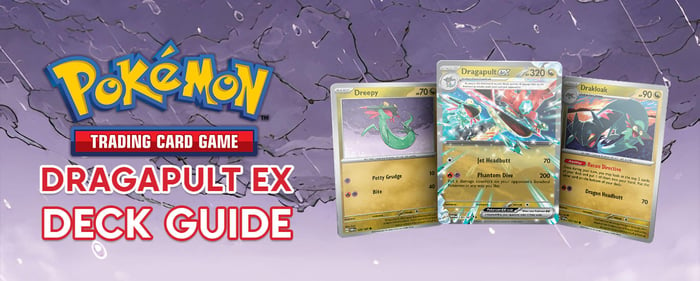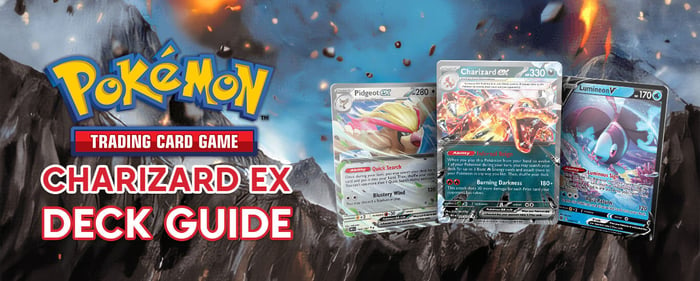Post rotation, there has been a shift in the Pokémon TCG landscape in Japan; a new archetype has come to the fore, taking acclaim and accolades across tournaments. I am, of course, talking about the Dragapult ex deck.
The centrepiece of this archetype is the pseudo legendary from the Galar region, which has had a new card released as part of the Twilight Masquerade set. Alongside its pre-evolutions and a cast of familiar and new cards, Dragapult ex sends reverberations throughout the game with its ability to sweep and snipe.
So, what does a dragon deck powerful enough to destabilise the meta look like? What do you need to bring this beast to life?
Table of Contents
Deck List
In the current format, multiple playing methods have already emerged for Dragapult ex, meaning there’s no hard-and-fast rule on how to play it.
In fact, the below proposal blends the Natu/Xatu and Pidgey/Pidgeot ex builds for a hybrid approach to your Energy acceleration and draw engine needs. Together, they power up your four-four-three Dragapult ex evolution line and, of course, bolster the secondary attackers, too…
Deck Strategy
The Dragapult ex profile is premised around the potency of this dragon’s primary attack, Phantom Dive. Phantom Dive does a hefty 200 damage, which, as a base value, is more than some of the common big-hitters across the meta. The attack’s secondary effect is what elevates it, allowing you to place six damage counters on your opponent’s benched Pokémon in any way you like. This is that sweep and a snipe attack that comes at a fairly measly cost of one Fire Energy and one Psychic Energy.
With this, Dragapult ex can use Phantom Dive to chip away at some of your opponent’s bigger benched Pokémon, priming them for a takedown. Alternatively, supporter Pokémon such as Bibarel, Cleffa and Manaphy can be dragged into the fray. There’s not much hiding from this terrorising Tera type.

As with the staple Charizard ex decks, Pidgey and Pidgeot ex are in there too, stooping the best cards from your deck and adding them to your hand with the ability Quick Search. Of course, there are many you’ll want to seek out, depending on the match status, such as Iono and Boss’s Orders.
And with Dragapult ex's Phantom Dive attack requiring Psychic Energy and Fire Energy, Xatu becomes an interesting foil for the set up, synergising seamlessly into the profile through its ability, Clairvoyant Sense. Supporting both Energy acceleration and draw capabilities, Xatu uses its telepathic ability to allow you to attach one Psychic Energy from your hand to one of your benched Pokémon. If you do this, you can draw two cards from your deck. At this point, you are essentially foreshadowing the damage Dragapult ex promises to unleash.
As for the rest of the cast in this strategy, Radiant Alakazam maximises the effect of the damage counters you place on your opponent’s benched Pokémon with Dragapult ex. The telekinetic troublemaker uses the ability Painful Spoons to truly punish your opponent by shifting up to two damage counters from one Pokémon to another once per turn. And, as ever, it can also chip in with the odd attack.

Naturally, the others feature in more supporting roles, with Manaphy offering bench protection, Cleffa acting as a draw engine, and Rotom V helping you to avoid a slow start and quickly get up to speed during the game.
Then, there’s the Trainer cards at hand. Alongside the seasoned staples such as Buddy-Buddy Poffin, Rare Candy, Boss’s Orders and Iono (which likely need little introduction), there are some less featured Supporters, Stadiums, Technical Machines, Tools and Items.
For example, you can use the Supporter card Mela to reclaim ground after having a Pokémon knocked out. The card allows you to attach a Fire Energy from your discard pile to one of your Pokémon and draw until you have six cards in your hand – a flaming retribution to reignite your Dragapult ex. Then, you have the ACE SPEC Scoop Up Cyclone, which allows you to put one of your Pokémon and all attached cards back into your hand. This works well when things are getting a little testing for Dragapult ex. And just to mention another, we have Technical Machine: Devolution, which in essence de-evolves one of your opponent’s Pokémon, opening up the possibility of easier knock-outs. A Charmeleon falls more easily than a Charizard ex.
How can the deck be upgraded?
For all its success in Japan, there have been reports that the Dragapult ex deck build has struggled to get up to speed in online play. So, you should always note the alternative variations within the archetype and tweak them to get the best out of your primary attackers.
Chief among these variations is the Lost Zone engine – a well-loved mechanic notorious for its successful playability with Giratina VStar. That same success is ready to lend itself to this new dragon card and power up its Phantom Dive attack with unique energy acceleration.
Whether you go first or second during the game, you’ll want to begin by loading cards into the Lost Zone, preferably using Lost Origin Comfey and its ability, Flower Selecting. Flower Selecting is incredibly useful as it allows you to look at the top two cards of your deck and add one to your hand and one to the Lost Zone. But this begs the question, why would you want to send cards to the Lost Zone?
The answer lies in the power of cards such as Mirage Gate, which can be played if you have seven or more cards in your Lost Zone. With Mirage Gate, you can search your deck for any two Energy cards and attach them to your Pokémon in any way you like. Enter Dragapult ex, the obvious beneficiary of this set up, with its slightly awkward requirement of one Fire and one Psychic Energy for Phantom Dive. Mirage Gate makes it that little bit less awkward and can help you to load that attack with greater ease.
Once you have this approach in place, you can double down on increasing the card count in your Lost Zone with options such as Lost City – a Stadium card that sends any Pokémon that is knocked out straight to the Lost Zone instead of the discard pile. Then, with the Supporter Colress’s Experiment, you can look at the top five cards of your deck, add three to your hand, and discard the rest to the Lost Zone. In short, you’ll have plenty of ways to get that engine into play.
This Lost Zone approach gives you plenty of attacking options, aside from Dragapult ex. The gem-loving gremlin Sableye allows you to double down on your damage counter plays using its attack, Lost Mine. Lost Mine allows you to place 12 damage counters on your opponent’s Pokémon in any way you like, as long as are 10 cards in the Lost Zone. With this, you can either lay the foundations for Dragapult ex to build upon using Phantom Dive or vice versa.
You also have Cramorant, which can be a solid early-game attacker, bypassing energy requirements using its ability, and Lost Provisions. Lost Provisions says that if there are four or more cards in the Lost Zone, Cramorant's Spit Innocently attack (which normally costs three Energy) can dish out 110 damage for free. You can push Cramorant one step further with the Tool card, Technical Machine: Crisis Punch, which can be attached to your Pokémon to give them an attack that does 280 damage if your opponent has one Prize Card left. The attack costs three Colourless Energy, but remember, Lost Provisions can waive any energy requirements with the correct conditions. It’s quite the boon for a basic Pokémon.
Finally, you’ll want to build in approaches that allow you to come from behind during the game should your opponent begin to take more Prize Cards than you. Here, we have multiple options. For example, both Bloodmoon Ursaluna ex and Radiant Charizard require less Energy to attack if your opponent has taken the lead with Prize Cards while being able to deal out 240 and 250 damage, respectively. Both are bandied as options, though Radiant Charizard may be favourable given it doesn’t have that ex status and has Fire Energy requirements like Dragapult ex.
So while this dragon set-up makes itself well-known across the current meta, the question is: ‘are you ready to sweep and snipe with Dragapult ex?’
Check out the full collection of Pokémon Trading Cards.


 4 x
4 x  4 x
4 x  2 x
2 x  2 x
2 x  2 x
2 x  2 x
2 x  1 x
1 x  1 x
1 x  1 x
1 x  3 x
3 x  2 x
2 x  2 x
2 x  1 x
1 x  4 x
4 x  3 x
3 x  2 x
2 x  3 x
3 x  1 x
1 x  1 x
1 x  1 x
1 x  1 x
1 x  1 x
1 x  1 x
1 x  1 x
1 x  1 x
1 x  1 x
1 x  5 x
5 x  3 x
3 x 







